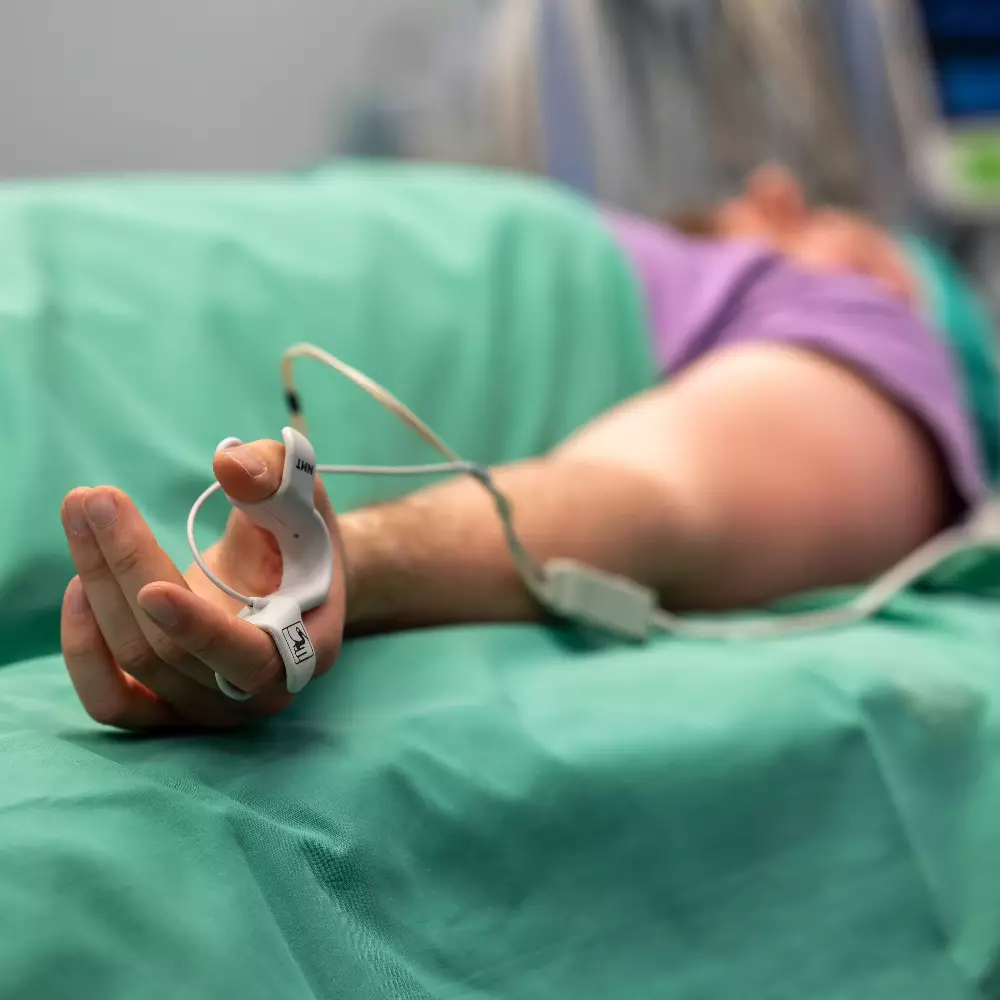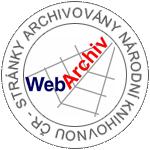Neuromuscular monitoring - 2025
Neuromuscular blocking agents (NMBA) are drugs with potentially life threatening effects for the patient. Therefore the monitoring of neuromuscular transmission during the operation is done according to the Czech Society of Anaesthesia, Resuscitation and Intensive Care and it is considered to be a standard procedure in patients care. The objective evaluation of the depth of relaxation gives the anaesthesiologist a valuable information that aids in his decision making about the immediate care. The main goal of this algorithm is to introduce the audience to the basic informations and options about neuromuscular monitoring and furthemore, to point to its importance in bringing the best possible care to the patient according to the European guidelines of 2024.
Review
The presented algorithm for solving clinical situations related to the correct practice of monitoring neuromuscular blockade and its reversal at the end of surgery is an excellent example of the systematic didactic activities of the Akutně.cz portal. The decision-making processes described in the algorithm are based on practice, contain recent information, and are beneficial not only for students or young doctors.
Sources
FUCHS-BUDER, et al. Peri-operative management of neuromuscular blockade: A guideline from the European Society of Anaesthesiology and Intensive Care. European Journal of Anaesthesiology 40(2):p 82-94, February 2023. | DOI: 10.1097/EJA.0000000000001769
ADAMUS, Milan. Monitoring of neuromuscular transmission in anaesthesiology. Olomouc: Palacký University, 2007. ISBN 978-80-244-1718-9.
BARASH, Paul G., Bruce F. CULLEN a Robert K. STOELTING. Clinical anaesthesiology Praha: Grada, 2015. ISBN 978-80-247-4053-9.
ORTIZ-GÓMEZ, J. R., F. CARRASCOSA, J. J. PÉREZ-CAJARAVILLE, J. A. PERCAZ-BADOS a C. AÑEZ. Comparative study of intubating conditions at the first minute with suxamethonium, rocuronium and different priming techniques of rocuronium. European Journal of Anaesthesiology [online]. 2005, 22(4), 263-268 [cit. 2017-11-06]. DOI: 10.1017/S026502150500044X. ISSN 0265-0215. Available at : https://insights.ovid.com/crossref?an=00003643-200504000-00004
STANKIEWICZ-RUDNICKI, Michał. Blokada nerwowo-mięśniowa u osób w podeszłym wieku. Anestezjologia Intensywna Terapia [online]. 2016, 48(4), 257-260 [cit. 2017-11-06]. DOI: 10.5603/AIT.2016.0045. ISSN 1731-2531. Available at :
https://journals.viamedica.pl/anaesthesiology_intensivetherapy/article/view/49318
FAGERLUND, Malin Jonsson, Heidrun FINK, Eva BAUMÜLLER, et al. Postanaesthesia pulmonary complications after use of muscle relaxants in Europe. European Journal of Anaesthesiology [online]. 2016, 33(5), 381-382 [cit. 2017-11-06]. DOI: 10.1097/EJA.0000000000000363. ISSN 0265-0215. Available at : http://content.wkhealth.com/linkback/openurl?sid=WKPTLP:landingpage&an=00003643-201605000-00013
KOPMAN, Aaron F., Nabeel A. KHAN a George G. NEUMAN. Precurarization and Priming: A Theoretical Analysis of Safety and Timing. Anesthesia & Analgesia [online]. 2001, 93(5), 1253-1256 [cit. 2017-11-06]. DOI: 10.1097/00000539-200111000-00042. ISSN 0003-2999. Available at : http://content.wkhealth.com/linkback/openurl?sid=WKPTLP:landingpage&an=00000539-200111000-00042
OZTURK ARIKAN, Fatma Gulcin, Guldem TURAN, Asu OZGULTEKIN, Zubeyir SIVRIKAYA, Bekir Cem COSAR a Dondu Nisa ONDER. Rocuronium: automatic infusion versus manual administration with TOF monitorisation. Journal of Clinical Monitoring and Computing [online]. 2016, 30(5), 545-550 [cit. 2017-11-07]. DOI: 10.1007/s10877-015-9751-2. ISSN 1387-1307. Available at : http://link.springer.com/10.1007/s10877-015-9751-2
GLASS, P. S. A., W. WILSON, J. A. MACE a R. WAGONER. Is the Priming Principle Both Effective and Safe?. Survey of Anesthesiology [online]. 1989, 4(2), 207- [cit. 2017-11-08]. DOI: 10.1097/00132586-198908000-00005. ISSN 0039-6206. Available at : https://insights.ovid.com/crossref?an=00132586-198908000-00005
AZIZ, L., S. M. JAHANGIR, S. N. S. CHOUDHURY, K. RAHMAN, Y. OHTA a M. HIRAKAWA. The Effect of Priming with Vecuronium and Rocuronium on Young and Elderly Patients. Anesthesia & Analgesia [online]. 1997, 85(3), 663-666 [cit. 2017-11-08]. DOI: 10.1097/00000539-199709000-00032. ISSN 0003-2999. Available at : http://content.wkhealth.com/linkback/openurl?sid=WKPTLP:landingpage&an=00000539-199709000-00032
LEDOWSKI, Thomas, Laura FALKE, Faye JOHNSTON, Emily GILLIES, Matt GREENAWAY, Ayala DE MEL, Wuen S. TIONG a Michael PHILLIPS. Retrospective investigation of postoperative outcome after reversal of residual neuromuscular blockade. European Journal of Anaesthesiology [online]. 2014, 31(8), 423-429 [cit. 2017-11-08]. DOI: 10.1097/EJA.0000000000000010. ISSN 0265-0215. Available at : http://content.wkhealth.com/linkback/openurl?sid=WKPTLP:landingpage&an=00003643-201408000-00006
OZTURK, Omur, Gulbin YALCIN SEZEN, Handan ANKARALI, Onur OZLU, Yavuz DEMIRARAN, Hakan ATES a Burhan DOST. Effect of Smoking on Reversing Neuromuscular Block. Turkish Journal of Anesthesia and Reanimation [online]. 2016, 44(4), 206-211 [cit. 2017-11-18]. DOI: 10.5152/TJAR.2016.97720. ISSN 21490937. Available at :
http://www.jtaics.org/jvi.aspx?pdir=tard&plng=eng&un=TARD-97720
MURPHY, Glenn S. a Sorin J. BRULL. Residual Neuromuscular Block. Anesthesia & Analgesia [online]. 2010, 111(1), 120-128 [cit. 2017-11-29]. DOI: 10.1213/ANE.0b013e3181da832d. ISSN 0003-2999. Available at : http://Insights.ovid.com/crossref?an=00000539-201007000-00024
BRULL, Sorin J. a Glenn S. MURPHY. Residual Neuromuscular Block. Anesthesia & Analgesia [online]. 2010, 111(1), 129-140 [cit. 2017-11-29]. DOI: 10.1213/ANE.0b013e3181da8312. ISSN 0003-2999. Available at : http://Insights.ovid.com/crossref?an=00000539-201007000-00025
PEARSE, Rupert M, Rui P MORENO, Peter BAUER, et al. Mortality after surgery in Europe: a 7 day cohort study. The Lancet [online]. 2012, 380(9847), 1059-1065 [cit. 2017-11-06]. DOI: 10.1016/S0140-6736(12)61148-9. ISSN 01406736. Available at : http://linkinghub.elsevier.com/retrieve/pii/S0140673612611489
MILLER, Ronald D. Miller's anesthesia. 7th ed. Philadelphia, PA: Churchill Livingstone/Elsevier, c2010. ISBN 9780443069598.
ADAMUS, Milan. Physiology of neuromuscular transmission. Muscular relaxants in anaesthesiology. In: News in anaesthesiology, algesiology and intensive care 2013: Omnibus from 5. conference CEEA, held in Košice between 27. - 29.11.2013. Prešov: Akcent print, 2013, page 73 - 78. ISBN: 978-80-89295-52-4
Available at : http://www.lf.upjs.sk/ceea/doc5/Zbornik%20CEEA%202013%205_kurz.pdf
STOURAC, P., M. ADAMUS, D. SEIDLOVA, T. PAVLIK, et al. Low-Dose or High-Dose Rocuronium Reversed with Neostigmine or Sugammadex for Cesarean Delivery Anesthesia: A Randomized Controlled Noninferiority Trial of Time to Tracheal Intubation and Extubation. Anesthesia & Analgesia, 2016, 122(5).
ADAMUS, M., ČERNÝ, V., CVACHOVEC, K., et al. Stanovisko k přístrojové monitoraci hloubky nervosvalové blokády. ČSARIM, 2017. [online] Available at : http://www.csarim.cz/storage/app/media/uploaded-files/stanovisko-k-pristrojove-monitoraci-hloubky.pdf
ADAMUS, M., CVACHOVEC, K., ČERNÝ, V. , ROGOZOV, V., ŠTOURAČ, P. Zásady bezpečné anesteziologické péče. Doporučený postup ČSARIM, 2017. [online] Available at : http://www.csarim.cz/storage/app/media/uploaded-files/DP_CSARIM_Zasady_bezpecne_anestezie_final_101217.pdf
CHECKETTS, M. R., R. ALLADI, K. FERGUSON, et al. Recommendations for standards of monitoring during anaesthesia and recovery 2015: Association of Anaesthetists of Great Britain and Ireland. Anaesthesia[online]. 2016, 71(1), 85-93 [cit. 2018-05-30]. DOI: 10.1111/anae.13316. ISSN 00032409. Available at : http://doi.wiley.com/10.1111/anae.13316
Learning targets
2. The student can recognize different methods and modes of neuromuscular relaxation monitoring.
3. The student understands the principle of antagonizing neuromuscular blockade using different muscle relaxants.
Key points
2. The standard method for objective monitoring of muscle relaxation is TOF, PTC mode is used for deep blockade.
3. A safe TOF ratio value that excludes residual curarization is > 0.9, otherwise reversal is necessary. Sugammadex is a specific antagonist for rocuronium and vecuronium; neostigmine with atropine is used to antagonize other non-depolarizing relaxants.





